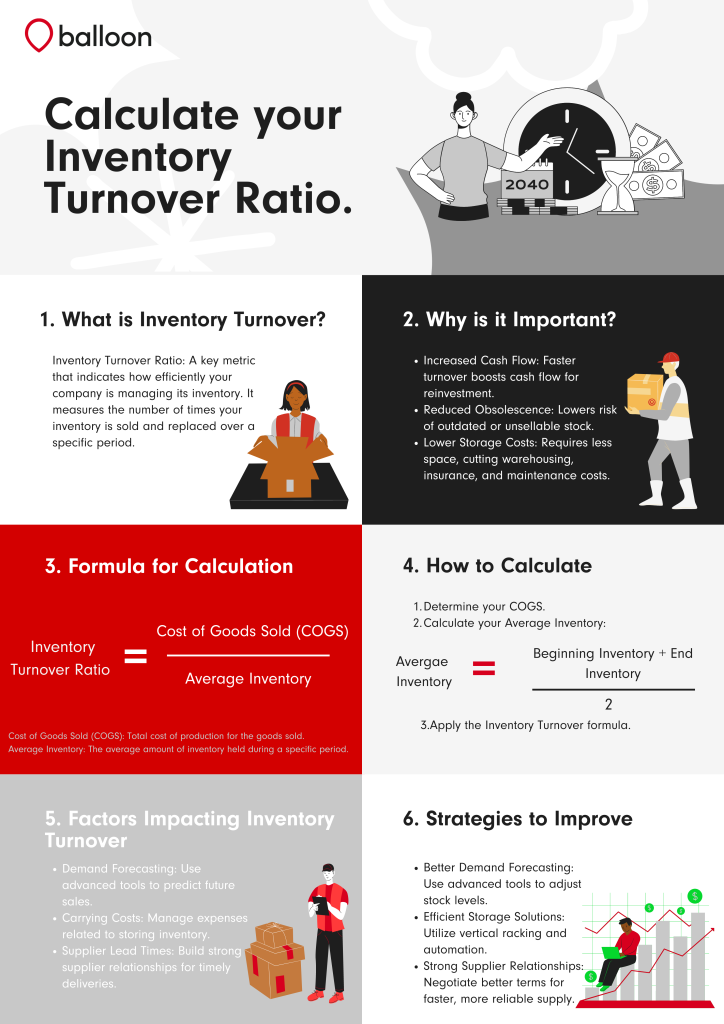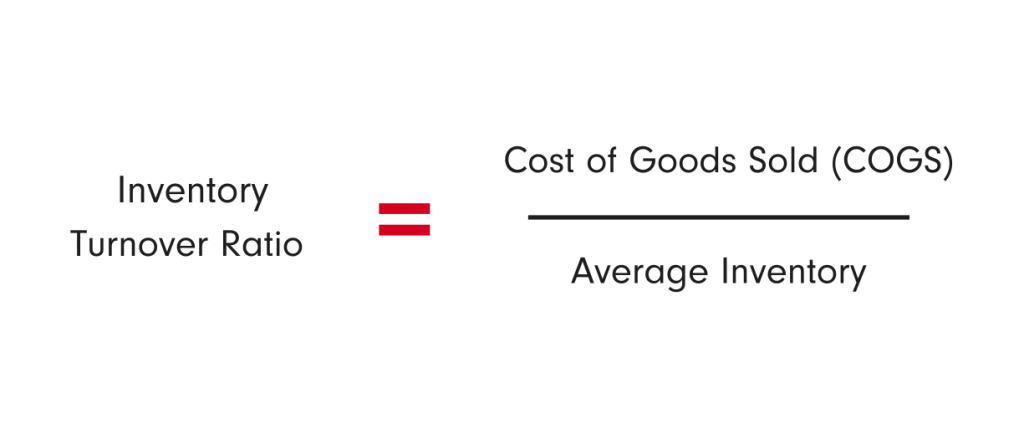How to Master Inventory Turnover.

Keeping tabs on your inventory is crucial for any business, but for warehouse and supply chain managers, it’s a game-changer. Understanding and mastering inventory turnover can be the difference between running a smooth operation and dealing with constant headaches.
This guide will walk you through what inventory turnover is, why it matters, and how you can optimise it for your business. By the end, you’ll have the tools and insights needed to enhance efficiency, reduce costs, and stay competitive.

What is Inventory Turnover?
Inventory turnover is a metric that indicates how often inventory is sold and replaced over a specific period. Essentially, it measures the efficiency with which a company can manage its stock. For warehouse and supply chain managers, understanding this metric is crucial as it directly impacts profitability and operational efficiency.
What is the Inventory Turnover Ratio?
The inventory turnover ratio is a key financial measure that indicates how effectively a company handles its inventory. It provides a more in-depth look at the relationship between sales and inventory levels. The ratio is calculated by dividing the cost of goods sold by the average inventory.

This ratio measures how often inventory is sold and replaced in a year. A high inventory turnover ratio indicates efficient inventory management, with goods selling quickly and inventory held for shorter periods. A lower ratio could mean overstocking or sales inefficiencies, resulting in longer storage times and higher holding costs.
By monitoring the stock turn ratio closely, warehouse and supply chain managers can make better decisions to optimize stock levels, improve cash flow, and enhance overall operational efficiency.
Frequency plays a pivotal role in leveraging the insights derived from the stock turnover formula and ratio. For optimal efficiency, it is recommended that warehouse and supply chain managers calculate these metrics on a monthly or quarterly basis.
Why Inventory Turnover Matters.

Inventory turnover is important for your business. High inventory turns mean you sell items fast, showing strong sales and good inventory management. Low turnover could mean problems like weak sales or too much inventory.
Inventory turnover is crucial for your business. It shows how quickly you sell items and manage your inventory effectively. A high turnover indicates strong sales and good inventory management.
On the other hand, a low turnover could signal issues like weak sales or excess inventory. In supply chain management, a good turnover ratio ensures you have the correct amount of stock when needed. This helps save money and reduces the risk of items becoming outdated.
Factors Affecting Inventory Turnover.

Several factors can impact your inventory turnover rate. Understanding these can help you make better decisions and optimise your operations.
Demand Forecasting.
Accurate demand forecasting is crucial for maintaining a high inventory turnover. By predicting how much stock you’ll need, you can avoid overstocking or understocking, both of which can be costly. Tools like AI and machine learning can enhance your forecasting accuracy by analysing past sales data and market trends.
Carrying Costs
Carrying costs like storage, insurance, and taxes can impact how quickly you sell your inventory. Higher carrying costs mean you need to sell more to make a higher profit margin. To reduce these costs, use efficient storage and regularly check your inventory.
Supplier Lead Times
The time it takes for suppliers to deliver goods can affect how quickly you sell your inventory. If suppliers take a long time, you may need to keep more safety stock, which can slow down your sales. To avoid this, work closely with reliable suppliers and use JIT inventory practices.
Benefits of High Inventory Turnover.

Maintaining a high inventory turnover comes with several benefits that can positively impact your business operations.
Increased Cash Flow
A high inventory turnover rate means you’re selling products more quickly, leading to faster cash flow. This enables you to reinvest in your business, whether it’s purchasing new stock, upgrading technology, or expanding operations.
Reduced Risk of Obsolescence
With a high inventory turnover, you’re less likely to hold onto outdated or unsellable stock. This reduces the risk of obsolescence and helps maintain a fresh and appealing inventory for your customers.
Lower Storage Costs
Efficient inventory management can significantly reduce storage costs. With a high turnover rate, you’ll need less space for stock, reducing expenses related to warehousing, insurance, and maintenance.
Downsides of Low Inventory Turnover.

While the benefits of high inventory turnover are clear, the downsides of low turnover should not be overlooked.
Higher Carrying Costs
Having too much inventory for a long time can increase costs. Keeping stock in your warehouse for a while means paying more for storage, insurance, and taxes. These expenses can reduce your profits.
Potential Losses Due to Obsolescence
Keeping too much inventory can lead to items becoming outdated and unsellable. This can result in having to sell them at a lower price or even losing money by writing them off completely.
Tied-Up Capital
Low inventory turnover means a lot of your money is stuck in unsold stock. This makes it hard to invest in other parts of your business like marketing, research, or expanding your product line.
Strategies to Improve Inventory Turnover.

Improving your inventory turnover rate requires a strategic approach. Here are some practical tips to help you optimise your inventory management.
Better Demand Forecasting
Investing in advanced demand forecasting tools can significantly improve your inventory turnover. By accurately predicting future sales, you can adjust your stock levels accordingly, reducing the risk of overstocking or understocking.
Efficient Storage Solutions
Implementing efficient storage solutions, such as vertical racking and automated storage systems, can help maximise your warehouse space. This not only reduces carrying costs but also makes it easier to manage and rotate stock.
Strong Supplier Relationships
Building strong relationships with reliable suppliers can help ensure timely deliveries and reduce lead times. Consider negotiating better terms with your suppliers, such as bulk discounts or faster shipping options, to optimise your inventory levels.
Conclusion.
It’s important to understand and control how quickly you sell your inventory to keep your supply chain running smoothly. By predicting demand, managing costs, and working closely with suppliers, you can improve your inventory turnover rate. This can lead to more money coming in, less outdated stock, and lower storage expenses.
Check your current turnover rate and try out the tips mentioned here to make your business run better. Remember, a well-handled inventory is crucial for making your business more profitable and successful.
Frequently Asked Questions.
A good inventory turnover ratio varies by industry, but generally, a higher turnover rate indicates more efficient inventory management. Aim for a turnover ratio that aligns with industry benchmarks and reflects strong sales and efficient stock management.
To calculate your inventory/stock turnover ratio, use the following formula:
This calculation will give you the number of times your inventory is sold and replaced within a specific period.
Several factors can impact how quickly you sell your inventory, such as predicting demand, holding costs, and supply lead times. By focusing on these factors, you can improve your inventory turnover and enhance your business operations. To become proficient at selling inventory and achieving business success, implement these tips and strategies.
Evaluate your current inventory management practices and make necessary adjustments to optimize efficiency. If you work on these things, you can sell your inventory faster and make your business run better. By employing these tips and strategies, you’ll excel at selling your inventory and driving the success of your business. Start looking at how you manage your inventory today and make changes to make things work better.
